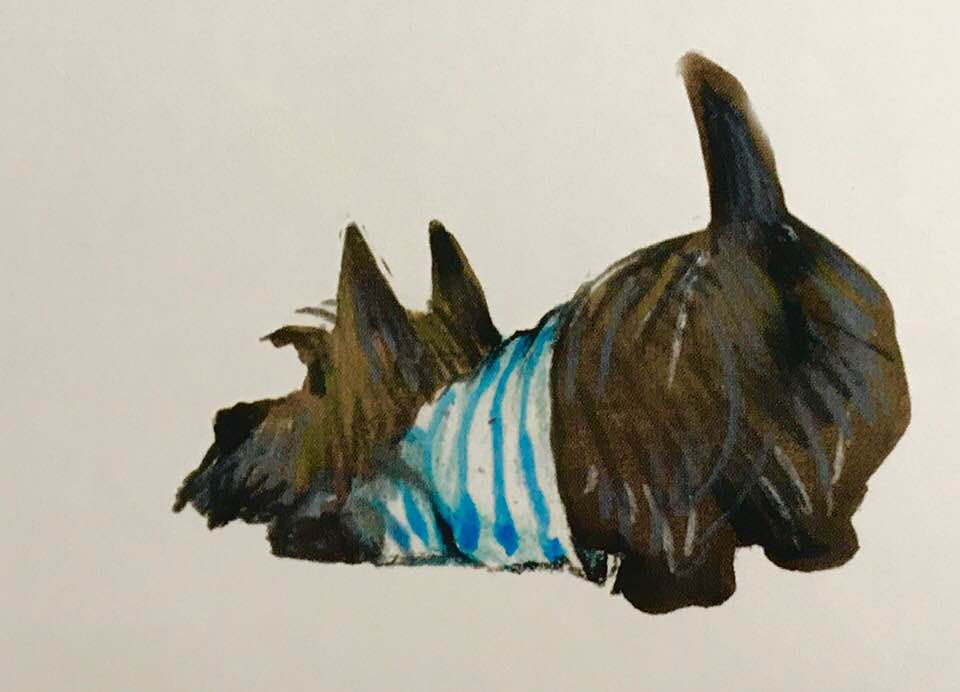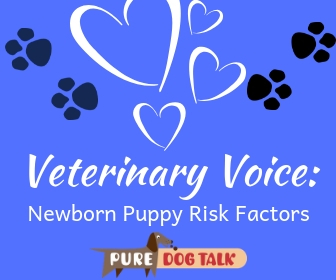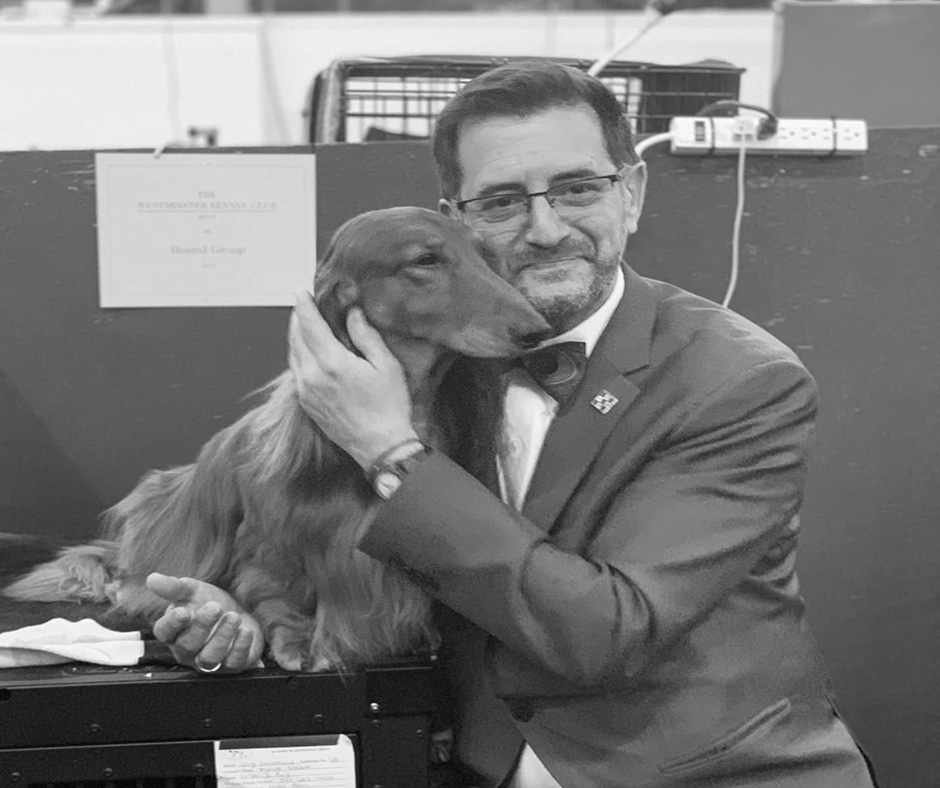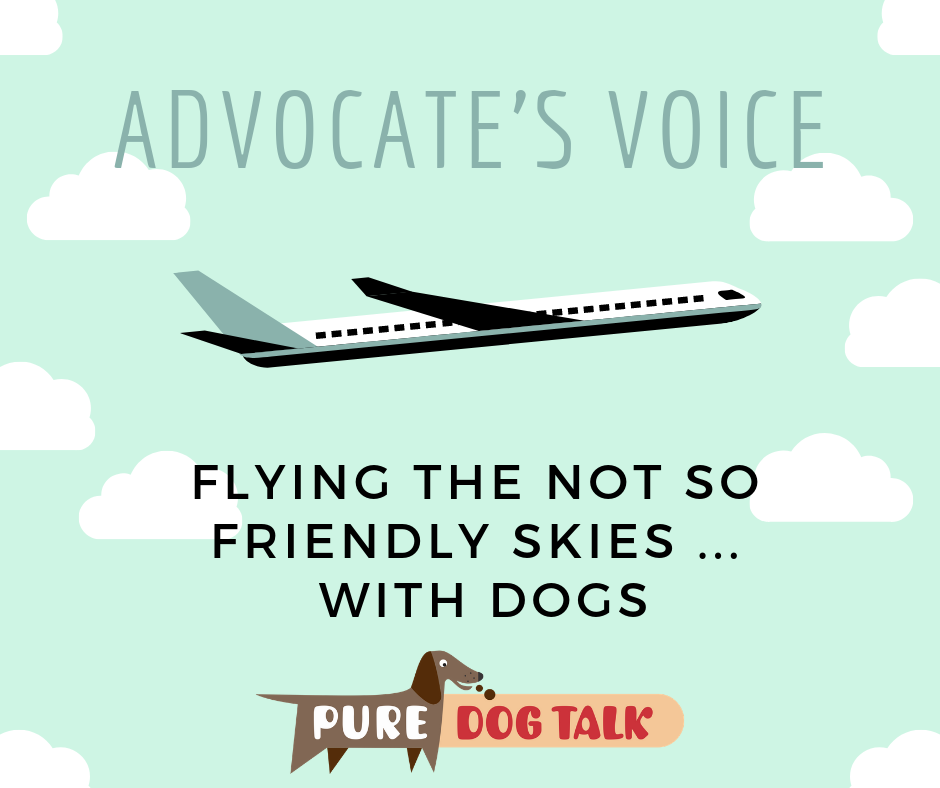269 – Authors: Clean Paws Are Very Important For a Scottie, You Know
Clean Paws Are Very Important For a Scottie, You Know
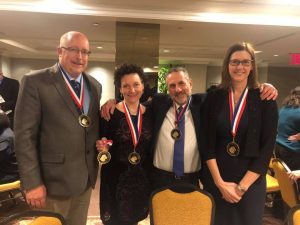
DWAA Award Winners Rod Ott, Pilar Kuhn, Larry Linder and Lisa Peterson at the awards banquet.
Pilar Kuhn and Rod Ott, authors of the award-winning children’s book “Clean Paws are Very Important for a Scottie, You Know” joined host Laura Reeves live at Westminster Kennel Club.
Scottie registrations are down, Kuhn said. The breed has witnessed an astonishing 70 percent decrease in overall number of registrations in the last 15 to 20 years.
Ott believes the “Adopt don’t shop” mentality has impacted registrations. He also notes that breeders have aged out and the overwhelming number of activities available makes it harder to get young people involved.
Kuhn and Ott share with Laura the five-year long story of developing the book idea, acquiring the illustrations, battling cancer, and the life-saving focus the project provided.
The hardback book brings children’s attention to purebred dogs, teaches life lessons and features charming illustrations of Scottish Terriers.
“With every purchase of our book, we will be donating a portion of the profits to help fund research for childhood cancer and to the Scottish Terrier Club of America Health Trust Fund,” Kuhn said. “Why? Our lives were changed several years ago when we sold a Bouvier in 2014 to a young girl Noah Nechemia who was going through recovery from medulloblastoma. She is now 4 years a Survivor. Childhood cancer receives less than 4 percent of all funding toward research and we are not OK with this. We are donating a portion of the profits from the sales of our books to the Cancer Prevention and Research Institute of Texas that did so much for Layla Stamp and her family and because of our dedication to preserving the Scottish Terrier, we want to help support research on health problems affecting Scottish Terriers.”
Bravo Scotties Chicory and Dee Dee will be going through the Pet Partners International Therapy Dog program to become certified Therapy Dogs and will later accompany the authors not only to hospitals to visit children, but also to elementary schools around the country. In the schools, Kuhn will read the book to children and help educate them on the Scottish Terrier and give kids a chance to meet a real, live Scottie.
268 – Veterinary Voice: Newborn Puppy Risk Factors
Managing the Neonate – Early Detection and Management of Newborn Risk Factors
By Dr. Marty Greer, DVM, JD
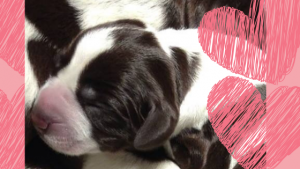 Breeders, experienced and inexperienced, will benefit from monitoring their newborn pups for the following parameters. This information is modified from recent research gleaned from Neocare in France.
Breeders, experienced and inexperienced, will benefit from monitoring their newborn pups for the following parameters. This information is modified from recent research gleaned from Neocare in France.
Having specific numbers to assess and monitor can be very helpful in early intervention with newborn pups, to avoid and prevent loss of these fragile new pups. Simply peeking into the whelping box does not give adequate information for either the breeder or the veterinarian asked to help with intervention.
Once you have collected this information, you can open a productive dialogue with your veterinary team. You can only manage what you can measure.
With this data, we can assess, intervene and provide specific treatments early enough in the first few days of life. This will significantly reduce neonatal loss, sometimes reported to be as high as 40 percent of newborn pups.
| Parameter | Risk | Managing the Risk | ||||||||||||||||||||||||
| 1. APGAR score Appearance, pulse, grimace, activity and respiration | A Problem APGAR score of <7 is associated with a 22x risk of death in the 1st 8 hours after birth.
Pups with an APGAR of 4-7 can achieve a 90% survival rate with appropriate intervention. |
Repeat or continue resuscitation efforts of suctioning, oxygen, epinephrine, caffeine, ventilation and veterinary care as indicated.
Pups with an APGAR score of 0 – 3 need intensive resuscitation efforts. |
||||||||||||||||||||||||
| 2. Weight | Low birth weight pups have an 81% chance of death in the 1st 48 hours. Pups in the lightest 25% of its breed has an increased risk of mortality during the 1st 2 days of life.
Weight loss – >4% weight loss associated with 8x risk of death. See formula. |
Digital Scale – essential – grams preferred.
Toy breeds – 100 – 200 gm Medium breeds 200-400 gm Large breeds 400 – 600 gm Giant breeds – 600 to 800 gm |
||||||||||||||||||||||||
| 3. Litter size | Large litters have a 4x increased risk of neonatal death associated with low birth weight. | Nutritional support with bottle or tube feeding. Nuby medi-nurser bottle recommended.
Plasma if colostrum is limited. |
||||||||||||||||||||||||
| 4. 3 H syndrome | Hypothermia à ileus of gut. à dehydration à hypoglycemia.
Room temperature – 75o F. Surface temperature – 90 to 95oF. Rectal temperature 94 – 96oF 1st 24 hours. Rectal temp 96-98o F 1st week. Hypothermic pups – 4x increased risk of death. Humidity should be 55% +/- 10%. Monitor hydration with MM moisture and urine color.
Plasma (IV, IO, SQ or oral) or colostrum orally along with appropriate antibiotic therapy should be prescribed. |
Rectal thermometer and Weather station to monitor temperature and humidity.
Pups cannot regulate their body temperature until they are 3 weeks old. PuppyWarmer incubator and oxygen concentrator recommended.
Increase surface temperature. Avoid use of heat lamp due to risk of dehydration, overheating and starting a fire. T.E. Scott Whelping nest recommended.
Avoid feeding until pup has appropriate rectal temperature for 1 hour. Pups should be warmed slowly. |
||||||||||||||||||||||||
| 5. Hypoglycemia | Glucose of 90 mg/dl or higher at 24 to 48 hours of age– normal.
Glucose < 90 gm/dl = 4x increased risk of death. |
Glucometer & foot pad stick.
Karo syrup or 5% dextrose. Tube or bottle feeding. PetTest glucometer and sticks recommended. |
||||||||||||||||||||||||
The following are the 5 P’s of safely tube feeding newborn pups. Do NOT sponge or eyedropper feed due to risk of aspiration. If pups are too weak to adequately suckle on a bottle, tube feeding may be safer. 1. Premeasure tube – enter to rib, 2. Pinch à vocalize before feeding, 3. Pass with chin down, 4. Pass down side, prefer left. 5. Prewarm – puppy and formula
|
||||||||||||||||||||||||||
| It is reported that in small animals doxapram is most likely to be beneficial in increasing respiratory efforts in neonates with low-frequency, gasping, an erratic patterns of breathing after receiving oxygen therapy (Traas 2009). | ||||||||||||||||||||||||||
267 – Dog Friendly Adventure Travel Takes Off
Travel with your dog to see amazing sights
David Blank founded Happy Tails Canine Adventure Tours, designed specifically for people who want to travel and adventure with their dogs.
 Blank is a professional tour guide and dog trainer who has been to 49 US states and 45 countries. He has hitchhiked from the US to Guatemala to study Spanish, backpacked and hitchhiked throughout East and South Africa, and spent a year motorcycling 20,000 miles throughout the US, Canada and Mexico with his dog Max. He has an MBA in International Business and has lived and worked in Mexico, Panama, Ecuador, China and France.
Blank is a professional tour guide and dog trainer who has been to 49 US states and 45 countries. He has hitchhiked from the US to Guatemala to study Spanish, backpacked and hitchhiked throughout East and South Africa, and spent a year motorcycling 20,000 miles throughout the US, Canada and Mexico with his dog Max. He has an MBA in International Business and has lived and worked in Mexico, Panama, Ecuador, China and France.
“As a guide, the only thing that is really important to me, besides sharing my love for the world, is that my clients have a unique, fulfilling experience that they will remember prominently and fondly for the rest of their lives!”
The Happy Tails tours are designed to learn about traveling with dogs and build great relationships with dogs while seeing new sights on guided tours.

The next tour travels to the desert southwest before the heat of summer. Tour participants will swim at Lake Powell, spend time on the Colorado River in Moab, Utah with a barbecue dinner on the river beach and hiking in the Grand Canyon.
“We want good travelers with dogs,” Blank said. “We want to make sure their dog gets along with other dogs. That the dogs are trained, behave well and are open to new experiences. We want to make sure everyone safe and everyone has a good time.
“The dogs get tired,” Blank said. “There is so much information for them, going to new places, seeing new stuff. The dogs’ safety is a premium for us.”
What about a PureDogTalk Adventure Tour?
Listeners, think about that! Anybody interested in a tour with host Laura Reeves, learning handling tips while seeing the sights, shout out!
Trip Advisor reviews of Happy Tails: https://www.tripadvisor.com/Attraction_Review-g49022-d14932745-Reviews-Happy_Tails_Canine_Adventure_Tours-Charlotte_North_Carolina.html
266 – Westminster KC Treasure Trove: The VOICE of MSG and Yukon Vet
Westminster KC Treasure Trove: The VOICE of MSG and Yukon Vet
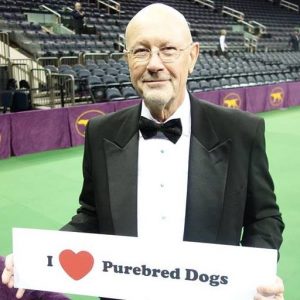
Michael LaFave, Westminster Kennel Club Announcer
“May we have the hound group please” may be the most thrilling line in dogdom. Westminster Kennel Club announcer Michael LaFave has been the announcer voice at Madison Square Garden for 18 years. Host Laura Reeves caught up with LaFave and Yukon Vet Dr. Michelle Oakley in New York City earlier this month.
LaFave was a Basset Hound fancier and president of Eastern Dog Club in Boston when the revered Roger Caras fell ill before the 2001 Westminster dog show. That last minute “fill in” assignment launched nearly two decades associated with his deep, powerful voice describing each dog being judged on the green carpet.
Intense moments and gorgeous dogs mark his tenure speaking to the thousands of fans filling the seats at the famed Manhattan venue. His favorite winner? Uno, the Beagle. His most memorable moment? The presentation to the Search and Rescue dogs who worked 9/11, just months after the tragedy.
Yukon Vet Debuts at Westminster

Nat Geo Wild series star Dr. Michelle Oakley, Yukon Vet.
Unlike LaFave, Oakley was brand new to Westminster Kennel Club. The TV star of the Nat Geo Wild reality series Yukon Vet was star struck herself as she met our famous canines. Fan girl moment? Biggie the pug. Oakley has a pug herself who she zips up in her snowmobile suit to take on two hour rides to her cabin.
She compared the agility competitors to sled dogs in their enthusiasm to work and reported “puppy breath wafting” from the floor of the show while watching the groups.
Her practical tips for living in sub-zero weather with dogs is to make sure they have boots, coats and possibly even an outdoor heat lamp for a place to potty when the weather is extreme.
Take a listen to her stories of weather change extremes in the Yukon, which disrupt and even kill hibernating animals.
Westminster was a “happy hunting ground” for podcast topics this year and we’re happy to share our discoveries with you.
265 – #takebackourstory: How YOU Can Help the Fight
#takebackourstory: how YOU Can Help the Fight for Breeders’ Rights
AKC Vice President of Government Relations Sheila Goffe shares details about the Political Action Committee. This fund, administered by AKC, is another tool helping breeders #takebackourstory.
“We are constantly fighting bad legislation,” Goffe said. “One of the things we can do that is the best short cut is make sure the folks who get elected understand us. The PAC provides campaign contributions to people running for office. Our Board looks at candidates who are already in office, people in position to make a difference. People who have worked with us in the past, we want to be sure they get re-elected.”
The AKC PAC makes contributions through YOU, Goffe said. “This is your dollars, but we work with local clubs to invite local people in specific district to deliver the donation. The enables us to develop relationships in the local community with local legislators.”
The reality of money in politics, Goffe noted, is it’s not a quid pro quo. “But when you hand them a check and they know who’s contributing, it gives you an opportunity to be heard. Then it’s up to us. We are the subject matter experts. Many groups writing breeder laws have no experience breeding dogs. We are the experts.”
#takebackourstory
Regulation vs legislation
AKCGR is currently tracking more than 1500 bills nationwide. One of the hotspots of contention is in Ohio.
“There’s a lot of confusion about what’s going on in Ohio,” Goffe said. “Definitions impacting hobby breeders have not changed. We are working with them directly, with the director of Ohio legislature, to ensure that the correct intent of the laws and regulations are adhered to.”
In a shorthand version of the legislative process, Goffe noted that once a bill passes and becomes law, administrators create regulations that implement the law. The people who are determining how the Ohio law is to be implemented are misinterpreting the regulation.
There are a whole lot of reasons that legislation and definitions matter, Goffe said. Proposed legislation needs to be reviewed because even though it may not impact breeders today, the question remains how easy would it be for it to have impact in the future.
“It may not apply to you until it’s “misinterpreted”… the intent of legislators is one thing, then it goes to how is it implemented. The application of the statute can be a problem,” Goffe said.
It matters. Pay attention. 98% of success is showing up.
https://www.akc.org/clubs-delegates/government-relations/toolbox/
https://www.akc.org/clubs-delegates/government-relations/federations/
264 — Carlos Puig: All About Dachshunds and Getting in a Dog’s Head
Carlos Puig: All About Dachshunds and Getting in a Dog’s Head
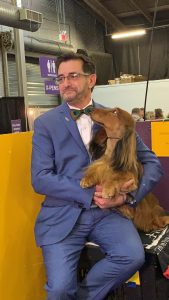
Handler Carlos Puig and Longhaired Dachshund, Burns, Hound group winner at the 2019 Westminster Kennel Club.
Anyone who watched the joy with which the Longhaired Dachshund, Burns, showed at Westminster Kennel Club last week, or loves Dachshunds in general, will appreciate this talk with handler Carlos Puig.
A Dachshund fancier, breeder and handler for 45 years, Puig brings out the pure spirit in each of his charges. How and why this “jazz pianist” of dog handlers does this is an amazing story. His encyclopedic knowledge of the Dachshund breed is equally impressive.
“(Dachshunds) are almost like an accordion,” Puig said. “They are very flexible because they had to be able to get in the badger den, maneuver underground and then back out.”
Dual Champion Does it All
In fact Burns, GCHP DC WALMAR-SOLO’S OMG SL JE, is believed to be the first dual champion of any breed to win a group at Westminster Kennel Club. Puig is proud that Burns has been successful in both field trials and earth dog events, proving that great show dogs can still do the work for which they were bred.
While Standard and Miniature Dachshunds have the same breed standard, Puig notes there are distinct differences between the varieties of coats and sizes. Smooths are the guard dogs, Longs are the snugglers and Wires will make you laugh, he said. And while Standards were bred for hunting badger, Minis are more about speed and were bred specifically for hunting rabbits and flushing deer.
“Back in the day (as the breed was developed in the 1800s) the best wires were standard longhairs bred to Dandie Dinmonts,” Puig said. “Which is why you still see lighter color hair on the heads of some Wire Dachshunds.”
Dog Handler as “Jazz Pianist”
Puig began his journey as a shy 11-year-old, house sitting for a neighbor who owned and showed Great Danes and later Dachshunds. He helped socialize puppies and groomed dogs for the owners while they were at shows because his parents were very protective and wouldn’t let him travel out of state.
“I learned to communicate with dogs before I learned to communicate with people,” Puig said. “I am grateful to the dogs…. they literally saved my life. I feed off the dog’s personality. You gotta get in their heads. I hate the robot dogs. There are never two dogs that are exactly alike. If you can’t pick up on that, you’ll get nowhere. I’m fortunate I started with Dachshunds, because I had to convince them they were doing what they wanted to do, not what I was making them do.”
263 – Flying the Not so Friendly Skies with Dogs PLUS Woof by WoofWest
Flying the Not so Friendly Skies with Dogs PLUS Woof by WoofWest
Sheila Goffe, AKC Vice President of Government Relations, shares what she’s learned from the airlines about flying with dogs, what her team is doing to help the purebred dog fancy and what we can do to help.
March 1 is the date Delta will stop flying dogs in crates larger than a 300 size. Goffe said her office has been developing relationships to be able reach out to airlines and have a voice in the conversation.
“Really think about what it is we can do to concisely explain to (the airlines) about our experience flying dogs. Their concerns are liability. We need to think like the airlines,” Goffe said. “Sharing YOUR experiences with us and with the airlines is invaluable.”
Goffe noted that her concerns about United Airlines are regarding breed specific limits.
“American Humane Association provided these guidelines. We’re trying to work with the airline and provide them with the science,” Goffe said. “We can’t make (the airlines) ship our dogs. Our choice is to be a good partner and help them.”
Fake Service Dogs – Just Say No
Flying “not your service dog” is hurting all of us, Goffe said by taking away the credibility of legitimate service dogs.
“When we go in there committing fraud, we are hurting ourselves. It’s understandable why. I’ve shared with airline groups that the more they restrict cargo the more they provide incentive to commit fraud,” Goffe said. “But, if you ever think about putting a vest on a show dog to get it where it’s going, remember you can potentially be putting a person who legitimately needs that help through a very traumatic experience.”
WxWW
 Stick around for a special guest appearance from David Frei discussing Woof by WoofWest, presented by Seattle Kennel Club. This innovative approach to bringing the public to purebred dogs includes “My Dog Can Do That,” as well as a booth with PureDogTalk friend Debra Hamilton on estate planning with your pets, a Veterinarian who can answer general questions, Meet the Breeds and more.
Stick around for a special guest appearance from David Frei discussing Woof by WoofWest, presented by Seattle Kennel Club. This innovative approach to bringing the public to purebred dogs includes “My Dog Can Do That,” as well as a booth with PureDogTalk friend Debra Hamilton on estate planning with your pets, a Veterinarian who can answer general questions, Meet the Breeds and more.
262 — Will Alexander on Grooming, Handling and Heroes
Will Alexander on Grooming, Handling and Heroes
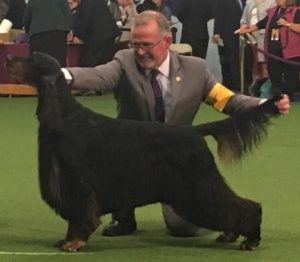
Will Alexander winning BOB in Gordon Setters at Westminster Kennel Club this week.
Canadian dog handling legend, Will Alexander, shares his memories, his handling tips and grooming tools that have brought him significant success in the last 25 years.
“My heroes were people like George Alston,” Alexander said. “He basically taught me to trim Irish Setters over the phone.”
“I always wanted to be a handler, but before embarking on a handling career I worked for Garry MacDonald in Canada, and for Bobby Stebbins in the States,” Alexander said.
Carving the picture
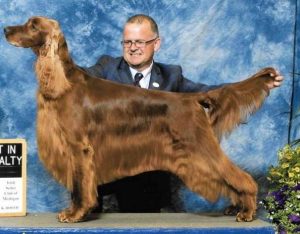
Will Alexander grew up with Irish Setters and learned from George Alston, over the phone, how to trim them.
Grooming is not a recipe, Alexander noted. Every dog is different. Famous for his meticulous grooming of setters particularly, Alexander describes a process to “build a shell around the dog” when trimming the back coat. He works with a stripping knife, his fingers, a grooming stone and, the most important piece, a bristle brush to bring up the oils in the coat.
Attention to detail
“I hate it when I hear “Oh, they won because they are so and so… well, they didn’t just grow up and they were so and so… they had to work hard to become so and so,” Alexander said. “It’s hard work. For every 15 minutes of fame there are 23 hrs 45 minutes working on your dog. It’s not age, it’s mileage.”
Tips of the trade
- Think in slow motion. In real time you’re doing exactly the right speed.
“When Miss P won the group at the Garden, George Alston called and yelled at me that I had gone too fast on the down and back. It was terrifying!”
- Attention to detail.
“I like to sit and watch the ring, pretend I’m in there already, making my mistakes in my head so I don’t make them in the ring.”
- “Old fashioned” isn’t bad
“I have a mind’s eye picture of the dogs. So much of type is in how they move, how they carry themselves,” Alexander said. “We need to be preserving the breeds not ‘improving’ them.”
Dream Best in Show Lineup
- English Springer Spaniel Ch. Salilyn’s Condor
- Borzoi Ch. Kishniga’s Desert Song
- Doberman Pinscher Ch. Brunswig’s Cryptonite
- Wire Fox Terrer ch galsul excellence
- Pekingese Ch. Wendessa Crown Prince
- Standard Poodle Ch. Rimskittle Ruffian
- German Shepherd Dog Ch Altana’s Mystique
BIS to Robert the Springer
For more information, videos, the book and more, visit http://www.doghandlingtips.com/
261 – AKC Doubles Your Cancer Research Dollars with a Matching Grant
AKC Doubles Your Cancer Research Dollars
More than 50 percent of dogs over 10 years old will be diagnosed with cancer. Dr. Diane Brown from AKC Canine Health Foundation wants to change that statistic.
AKC has pledged $250,000 in matching funds this year toward research into prevention, early diagnosis and treatment of all cancers in dogs. This enables individuals and clubs who donate to the matching fund to literally double the impact of every dollar.
Age is not a disease
“Age is not a disease,” Brown said. “There are quality of life issues to consider, but I believe we can get to a point of treating older dogs.”
Since people and dogs are affected by the same types of cancers, much of the research being done can be applied in what Brown describes as comparative oncology.
Prevention and Detection
In the prevention category, some cancer vaccines are a reality today and more are being studied. A melanoma vaccine is on the market now, Brown said.
Early detection of cancer saves lives in dogs and in people. Current research is looking at markers circulating in the dog’s system identified in blood samples that indicate increased risk for a specific disease.
Investing in personalized medicine is the wave of the future, Brown said. Using immunotherapy that is individualized for each dog is a very real possibility. She added that within five years many of these options will be realistically available.
Visit the AKCCHF crew on the west coast at the Beverly Hills Dog Show March 2-3. Brown encouraged visitors to share their stories and their questions.
Visit the AKCCHF website to learn more. And listen to past episodes with Brown to hear details on some of the research studies being conducted, particularly regarding epigenetics and hemangiosarcoma
Allison & Laura Handicap the Line Up at Westminster Kennel Club
Special: Allison & Laura Handicap the Line Up at Westminster Kennel Club
Special edition!! Allison & Laura jam on the Westminster Kennel Club show, the fabulous contenders and who may or may not rise to the top of the pack. Las Vegas oddsmakers have occasionally offered up a “line” on the Garden. But those are not Dog Show Divas! Pure Dog Talk brings you two of the sport’s long-time observers with input on who stands a good chance in the green carpet final seven line up this year.
Whiskey the Whippet and King the Wire Fox Terrier are high on the list of the potential winners. The Havanese, Bono, is peaking at the right time but could be pushed by Treasure, the Papillion. The Border Collie, Slick and the new German Shepherd Dog, Tony, are set to duke it out in the herding group. A surprise appearance from Elsa the Old English Sheepdog could upset that applecart.
Breed judging on Tuesday will make or break a lot of the group judging. Will Bean the Sussex Spaniel who won the group last year come back and play in BIS again? Or will the brand new English Setter, Penny, come on strong? Sporting is in play!
Working group is being judged by Jimmy Moses. Questions about what Doberman will get to the group and what Boxer will win the breed have a lot to do with which dog could win the group. Once again, up in the air. Allison says, “Jimmy Moses will pick a solid dog, but what’s he gonna get to work with?”
Jim Reynolds to Christine Erickson to Peter Green. Is this the fairy tale line up for King and Gabriel?
Allison is going all Ws…. She’s putting her line up as BIS to the Wire Fox Terrier and RBIS to the Whippet. Laura has her heart and her money, long odds, on the Wire Fox Terrier and the Havanese as RBIS.
Check out the Dog Show Divas with the best line on the best in show line up at Westminster Kennel Club on Pure Dog Talk! Vegas got nothin’ on us, baby!

